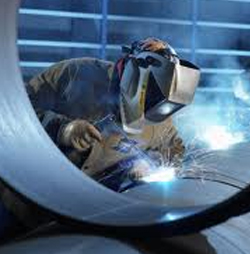If you’re interested in building bridges, ships and cranes, creating automobiles and their parts, water tanks and other metal products, then a career in metal fabrication and welding may be the one you’re looking for. Different fabrication and welding courses are available for beginners to tradesmen level.
Although anyone can work after obtaining any one-year fabrication and welding courses, he/she must complete at least four years of apprenticeship programs to enjoy a higher salary and better opportunities.
The next program available for those who completed the basics is an Associate of Applied Science in advanced welding. These programs may include structural fabrication and pipe welding, x-ray welding, and other advanced studies. These courses often involve more hands-on practice than theoretical studies.
If a student prefers to go the engineering route, he/she can enroll in a Fabrication and Welding Engineering course. Such programs deal with alloy and metal products in varying sizes and industries, although engineers have more opportunities in industrial companies. With engineering courses, students practice CAD design regularly, while studying how to make blueprints and manufacture motorway and railing structures, among others.
After finishing the apprenticeship, one can further enhance his/her career through master’s or doctorate programs. Master’s degrees are required for anyone planning to teach in community colleges or high schools. Courses include metallurgy, engineering, or metal sculpture. While continuing education and industry experience is enough to advance into a higher classification, those who wish to teach college students must obtain a doctorate degree in metal sculpture and design, chemistry, engineering, metal welding and fabrication, as well as physics.
Back to Top
Degree Options and Apprenticeships
Anyone interested in fabrication and welding courses have several options. First, they can take a one-year or two-year certification programs in welding, metal casing, precision metal fabrication, sheet metal, metal sculpture, or foundry casting, and Applied Science in fabrication and welding. If they have additional funds or time for an associate’s degree, they can take metallurgy classes or other general courses. Four-year bachelor’s degree programs include more studies in metalworking and physics, while metal fabrication courses highlight sculpture.Although anyone can work after obtaining any one-year fabrication and welding courses, he/she must complete at least four years of apprenticeship programs to enjoy a higher salary and better opportunities.
Fabrication and Welding Courses for Beginners
Depending on the type of fabrication and welding courses taken, beginner programs may include:- Reading blueprints, creating technical drawings and welding symbols;
- Learning drafting techniques using computer-aided design programs;
- Converting blueprints into metal, constructing metal shapes, and learning different metalworking tools for cutting and heating;
- Using fabrication tools, punching machines and shearing systems; and
- Welding and fabrication safety, which the Occupational Safety and Health Administrationrequire.
Advanced Training
After learning the basics of fabrication and welding, several advanced certification programs are available for those who wish to learn advanced techniques. During this time, a person can also begin his/her 4-year paid or non-paid apprenticeship in a company, which is a member of any professional welding association.The next program available for those who completed the basics is an Associate of Applied Science in advanced welding. These programs may include structural fabrication and pipe welding, x-ray welding, and other advanced studies. These courses often involve more hands-on practice than theoretical studies.
If a student prefers to go the engineering route, he/she can enroll in a Fabrication and Welding Engineering course. Such programs deal with alloy and metal products in varying sizes and industries, although engineers have more opportunities in industrial companies. With engineering courses, students practice CAD design regularly, while studying how to make blueprints and manufacture motorway and railing structures, among others.
After finishing the apprenticeship, one can further enhance his/her career through master’s or doctorate programs. Master’s degrees are required for anyone planning to teach in community colleges or high schools. Courses include metallurgy, engineering, or metal sculpture. While continuing education and industry experience is enough to advance into a higher classification, those who wish to teach college students must obtain a doctorate degree in metal sculpture and design, chemistry, engineering, metal welding and fabrication, as well as physics.
Back to Top
Fabrication and Welding

Fabrication and Welding Resources
- Home
- Custom Fabrication and Welding
- Fabrication and Welding Apprenticeships
- Fabrication and Welding Books
- Fabrication and Welding Companies
- Fabrication and Welding Courses
- Fabrication and Welding Engineering
- Fabrication and Welding Jobs
- Fabrication and Welding Schools
- Metal Fabrication and Welding
- Plastic Fabrication and Welding
- Precision Fabrication and Welding
- Stainless Steel Fabrication and Welding
- What is Welding and Fabrication
Sponsored Links
